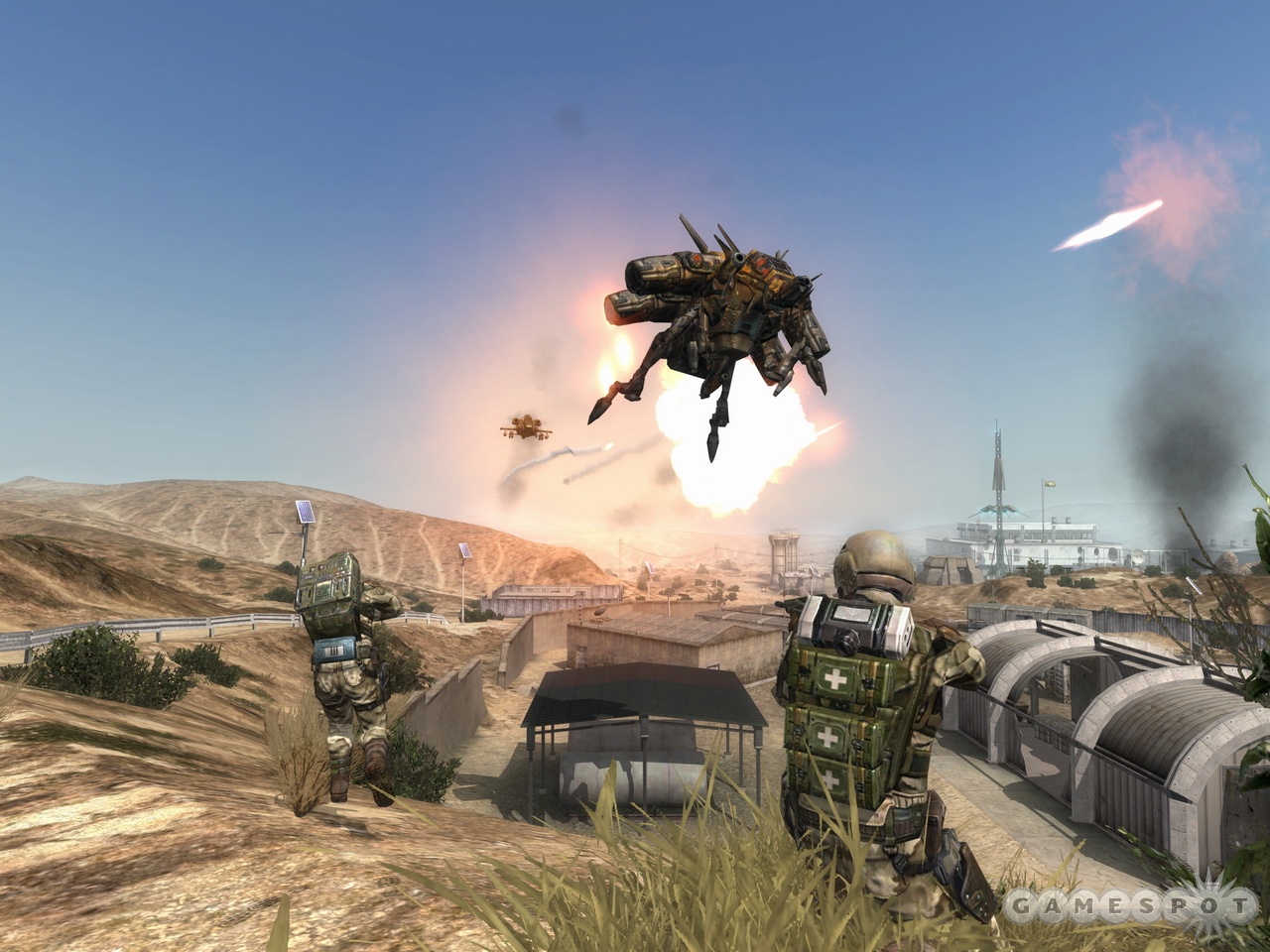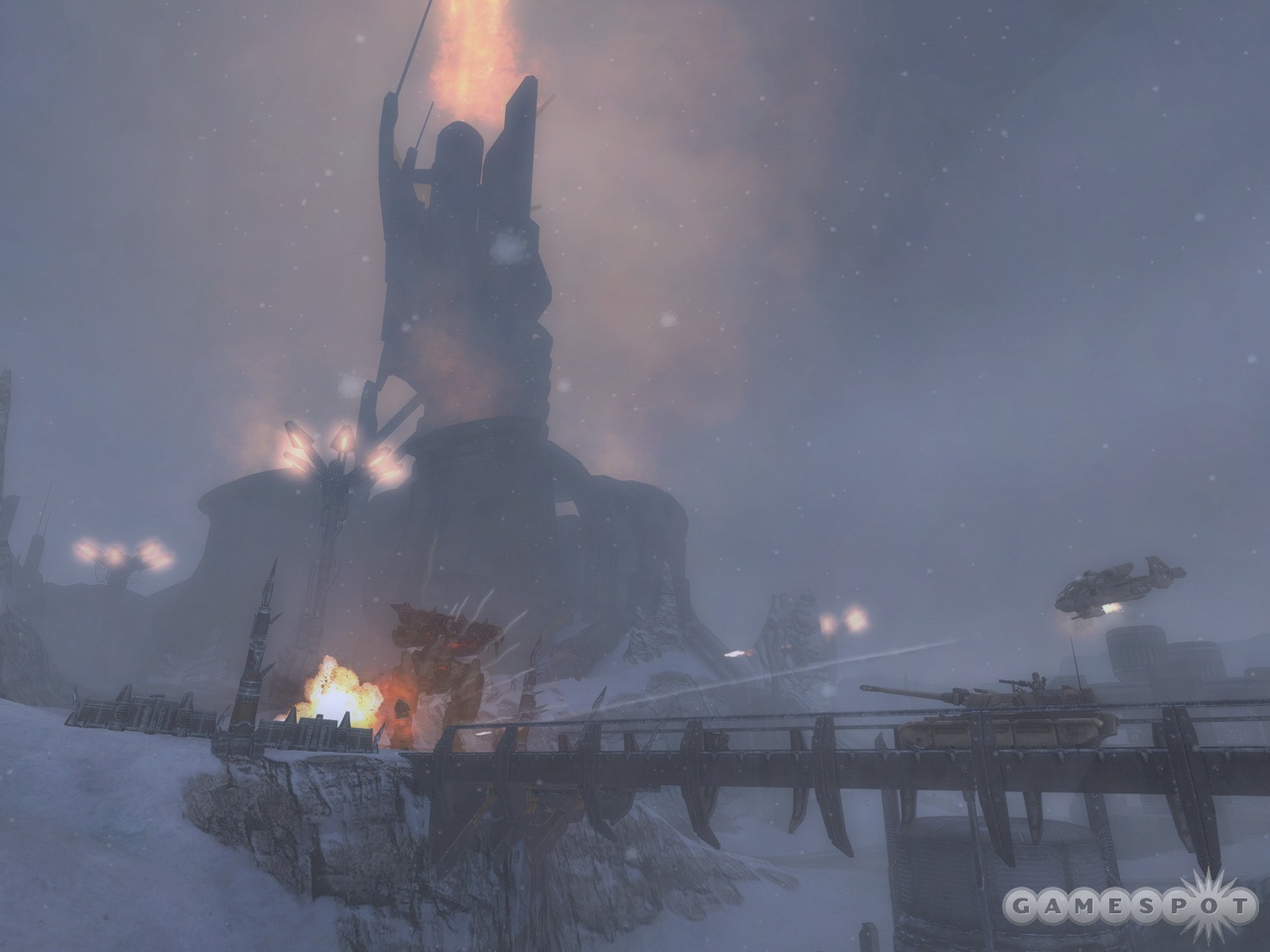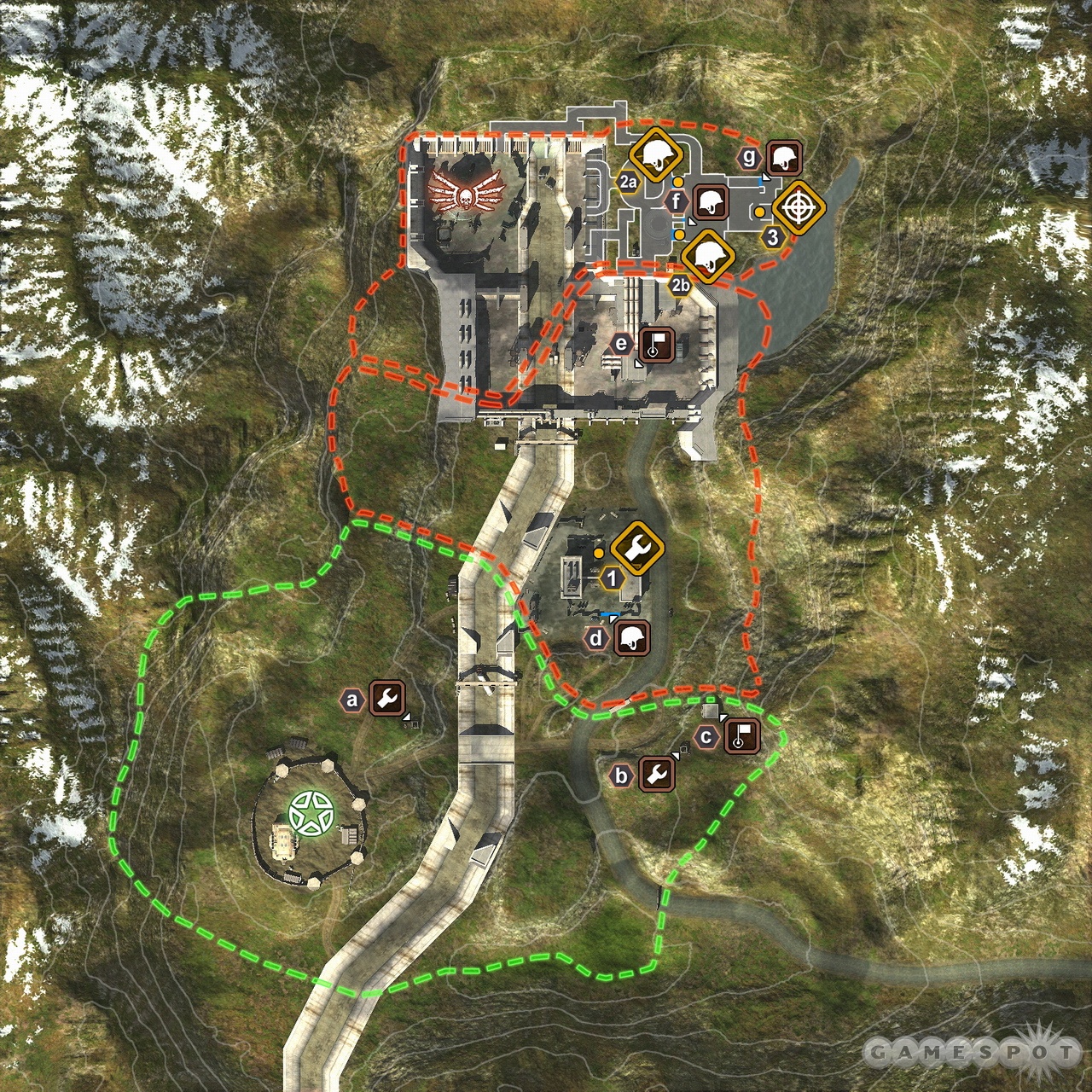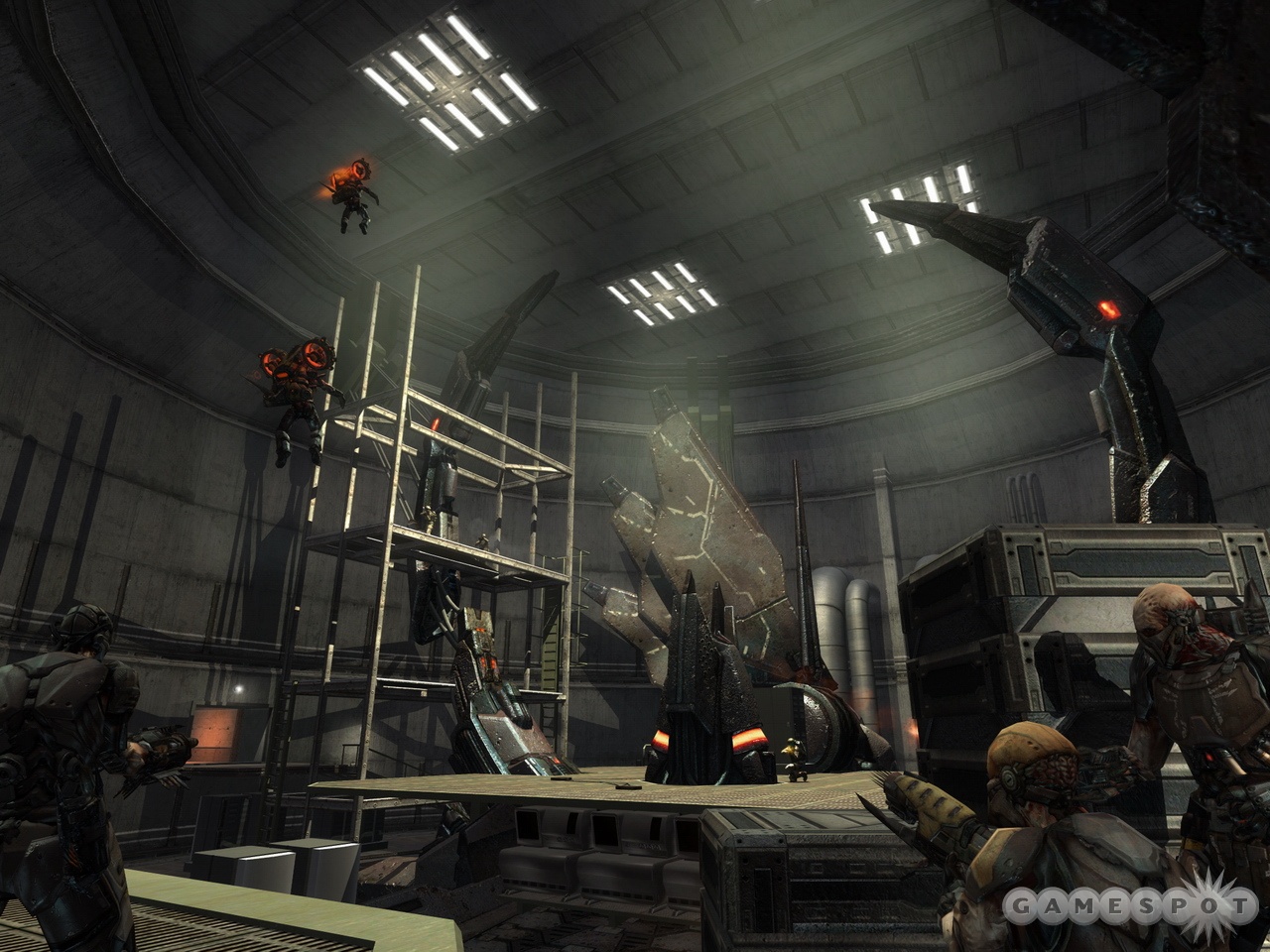Enemy Territory: Quake Wars Updated Hands-On - New Maps, More Gameplay, More Class Details
We get our hands dirty with an updated version of this action-packed team-based shooter. Get the details on new maps, and more gameplay and class impressions here.
If you take the running and gunning from a first-person perspective of a first-person shooter and make it a team effort, you usually end up with a bunch of players goofing around, not really trying to do anything together. Over time, more team-based shooters like Counter-Strike and the Battlefield series have encouraged players to act less like fools and more like a cohesive team by completing group objectives. The next game from publisher Activision and developers Splash Damage and id Software, Enemy Territory: Quake Wars, will push team-based gameplay even further with some intriguing new ideas and plenty of fast-paced shooter gameplay. We recently had a chance to sit down with an updated version of the PC game and have much to report.
As you may know from checking our previous coverage, Quake Wars takes place in the near future in the Quake first-person shooter universe. More specifically, it takes place in the middle of a war between the human Global Defense Force (GDF) and the strogg, the alien race from 1997's Quake II. In the game, you'll play either on the side of the GDF or the strogg in one of five primary roles: assault, medic, engineer, support, or scout; known on the GDF side as soldier, medic, engineer, field ops, and covert ops; and on the strogg side as aggressor, technician, constructor, oppressor, and infiltrator.

However, while these roles are roughly similar on both sides, they play out very differently in practice. The human GDF forces mostly use conventional weapons, such as assault rifles and pistols. The strogg forces use alien technology, including many of the weapons featured in 2005's Quake 4, such as the hyperblaster minigun, the lightning gun (which fires a continuous stream of electricity), the nailgun (which now fires bursts of nails like a shotgun), and the dreaded railgun sniper weapon, which has an adjustable long-range zoom lens.
Each class plays a basic role, and assault and scout characters can also vary up their abilities by choosing different primary weapons. For instance, soldiers and aggressors can act as shock troopers by choosing an GDF assault rifle or strogg lacerator as a primary weapon or act as anti-vehicle characters by picking the rocket launcher. When aimed from zoom mode, the rocket launcher can automatically lock on to enemy vehicles and emplacements once you draw a bead on your target for several seconds. Medics and technicians can drop health packs (as they could in Wolfenstein: Enemy Territory, Splash Damage's previous game) and revive fallen comrades. Engineers and constructors are crucial characters that can repair damaged vehicles and emplacements, build such defensive emplacements as anti-vehicle and anti-personnel gun turrets, and drop explosive mines. Field ops and oppressor characters can call in long-range artillery strikes. Finally, covert ops and infiltrator characters can use long-range sniper weapons, deploy radar emplacements to spy on the enemy, and disguise themselves as characters on the enemy team by stealing the appearance of a fallen enemy character (similar to the spy class in Wolfenstein).

In addition to these basic abilities, each side's classes have skills that make both sides asymmetrical and very interesting. For instance, the GDF field ops class can drop ammo packs on the ground (similar to the lieutenant class in Wolfenstein), while the strogg technician (the alien equivalent of the medic) can convert a fallen GDF soldier corpse into a forward spawn point for his allies. The differences also extend to each faction's vehicle set. The GDF has near-future versions of the kind of conventional land, air, and sea vehicles you'd expect, such as light trikes, armored buggies, larger land transports, hydrofoils, attack choppers, aerial transports, and heavy-duty tanks. The strogg have some roughly analogous vehicles, such as light landrovers, but they also have heavy air-attack vehicles, gigantic walking mechs, hovertanks that handle almost like low-flying aircraft, and personal jetpacks that let strogg snipers sneak onto high rooftops for the best vantage points.
Using the weapon of your favorite class to blast enemy players to bits is a good way to help your team, but Quake Wars seems to go beyond just gunfights to get players to coordinate. Every single game of Quake Wars takes place on a map that has been divided into different sectors, each of which houses an important objective that one side must accomplish (and the other side must prevent). These objectives include using a soldier or aggressor character's ability to set explosive charges to detonate a barrier, unlocking the next area.
Enemy Sighted!
These larger objectives appear in the upper-left corner of the screen as hovering text, and the game also has a "mission" system that lets you press the M key at any time to pull up any available sub-missions for any character. These sub-missions include securing a forward respawn point where your teammates can reappear when killed or missions for your current class, such as using an engineer's or constructor's building skills to repair a damaged bridge. If you successfully pull off these missions, your character nets experience points that eventually lead to "promotions," from private up to sergeant, and so on. These promotions grant immediate rewards to the character class you're playing. For instance, if you get a promotion as a soldier, your reward might be a faster lock-on time when using a rocket launcher against enemy vehicles and turrets.

During our time with the game, we had a chance to explore three different maps, which were simply named "valley," "sewer," and "Area 22." These maps took place in near-future versions of the Rocky Mountains, sewers beneath a Japanese city, and a bombed-out area in Nevada. We'd seen the valley map at the Electronic Entertainment Expo, which is a wide-open map that requires the GDF to repair a shattered bridge to pilot a gigantic mobile command point through a tunnel into strogg-controlled lines. After doing so, the GDF must push forward to the strogg base. The "sewer" map requires the GDF to blast through sewer grates with a soldier character to eventually hack the area's control system, flooding the sewer and killing off the entrenched strogg. Finally, in Area 22, the strogg must mount an assault against an GDF stronghold that is protecting captured "slipgate" technology--the teleporters that the strogg use to travel to new worlds and conquer them--by first disabling a nearby shield generator. According to Splash Damage creative director Paul "Locki" Wedgwood, the development team is strongly pushing for "map uniqueness" by building in a story and varied objectives that different classes are required to complete.
Each of the three maps had very different layouts, but they all had one thing in common: they were huge and had outdoor components. Quake Wars uses developer John Carmack's "megatexture" technology to quickly render huge, open environments with varied terrain and textures. In fact, many of the game's maps are so big that players will be able to sprint quickly from place to place on foot for an unlimited amount of time to make sure they can keep up with vehicles. Though you won't have any limit to how long you can sprint, your character will eventually start to breathe loudly and heavily, alerting everyone in the area to your presence.

The game's actual on-foot and vehicle gameplay remain as fast and loose as the last time we played the game in 2006. Even though Quake Wars has a great deal of depth in terms of its different objectives, each character class possesses many different skills, and the game uses a "reinforcement" system that controls when you'll be able to respawn after you've been shot down, the core of Quake Wars' gameplay is fast-paced shooting. With the exception of some of the larger flyers, most of the vehicles also seem extremely easy to pilot. And just about all of them, particularly the GDF's Titan Tank, have powerful mounted weapons that are easy to get the hang of and extremely satisfying to use.
While it might seem like a complicated team-based game on the surface, Enemy Territory: Quake Wars' gameplay is extremely inviting and should have something for both beginners and veterans of team-based shooters (and hopefully, with the game's built-in mission system to guide neophytes and its quick pacing, it'll be the game to turn many of those beginners into veterans). The game looks more promising each time we see it, and if Splash Damage and id make sure the game comes out polished and consistently great (the game was recently delayed), first-person shooter fans won't want to miss it. Quake Wars is scheduled for release on the PC, as well as on the Xbox 360 and the PlayStation 3, "when it's done."
Got a news tip or want to contact us directly? Email news@gamespot.com
Join the conversation